Catalyst
Relevant, engaging, and thought-provoking content from industry leaders related to the world of talent and work.


Relevant, engaging, and thought-provoking content from industry leaders related to the world of talent and work.
Relevant, engaging, and thought-provoking content from industry leaders related to the world of talent and work.

Promoting and retaining talent from within is one of the best ways to foster a more diverse and inclusive workforce. Facilitating internal mobility enables organizations to foster diversity on all levels of the organization by training and upskilling existing talent.
Contributors:
Jackie Ford, Professor, Durham University
Judy Ellis, SVP of DEI Advisory, AMS
Paul Modley, DEI Managing Director, AMS

During 2021, more than 47 million Americans voluntarily quit their jobs according to the US Bureau of Labor Statistics. Worker shortages are everywhere, with analysts from Goldman Sachs recently claiming the US is in the midst of its biggest talent shortage for 80 years – and that more jobs are available than workers can fill.
With organisations competing to fill positions and candidates fielding multiple offers, companies are being forced to massively hike salaries to ensure existing talent stays, while at the same time struggling to bring new hires onboard.
Issues like candidate ghosting – where hires cut contact with an employer or even fail to turn up on their first day, having found a better offer – are growing, with 28% of jobseekers admitting to ghosting and 8% simply not turning up, according to a 2021 Indeed survey.
One defence against the competing need for new talent and retaining existing employees is career mobility. Not only does it provide employees with opportunities for growth, development and reskilling, but it also can help drive another key metric for many businesses – greater diversity and inclusion.
In fact, mobility and diversity and inclusion leaders face similar challenges. Both are looking to attract the best talent and develop future skills capabilities, both are looking to fill talent gaps, and both are looking for new ways to engage and retain their best people. So how can talent leaders improve diversity and inclusion through career mobility?
“Research by JR Keller and others has shown that internal hires outperform external hires. Organisations have much more information about internal candidates than external ones, so businesses are increasingly thinking of their existing employees as ‘talent rich’ and looking at how they can utilise their skills in different roles,” says Judy Ellis, senior vice president of DEI, advisory at AMS.
“The problem is that internal moves and promotions tend to be a result of the network of the person looking to move. When you’re dealing with diversity, typically the more your dimensions of diversity separate you from the mainstream, the less networked you are and the less people are aware of your accomplishments,” she adds.
Combating this ‘who you know, not what you know’ culture requires being more explicit about the opportunities available internally and better understanding the capabilities of your existing talent.
This could mean creating a talent marketplace by posting all roles internally and looking at sponsorship of underrepresented high potential talent, placing them in specific talent programmes where they have access to senior leaders and their skills and accomplishments are exposed to new networks and opportunities.
It also means being aware of how your internal communications and employee engagement strategies impact different demographics. Two-way communication is key.
“I’ve seen issues with getting women and people of colour to apply for internal roles. In focus groups I conducted for clients, many saw internal postings as perfunctory, believing hiring managers had already chosen their desired candidate, so few believed in the process. At the same time, senior leaders were wondering why they had a lack of underrepresented applicants,” says Ellis.
“I found unsuccessful candidates often received no feedback about why they weren’t selected for a role. Therefore, when they saw the position filled by someone else, they determined the hiring manager had ‘pre-selected’ them. Failing to close the communication loop with unsuccessful candidates impacts them and everyone they talk to. Hiring managers should give specific feedback to candidates so they understand how to build their capabilities. While this may seem labour intense, it pays dividends to the individual and their network, instilling confidence in the overall process,” she adds.
During 2021, more than 47 million Americans voluntarily quit their jobs according to the US Bureau of Labor Statistics. Worker shortages are everywhere, with analysts from Goldman Sachs recently claiming the US is in the midst of its biggest talent shortage for 80 years – and that more jobs are available than workers can fill.
With organisations competing to fill positions and candidates fielding multiple offers, companies are being forced to massively hike salaries to ensure existing talent stays, while at the same time struggling to bring new hires onboard.
Issues like candidate ghosting – where hires cut contact with an employer or even fail to turn up on their first day, having found a better offer – are growing, with 28% of jobseekers admitting to ghosting and 8% simply not turning up, according to a 2021 Indeed survey.
One defence against the competing need for new talent and retaining existing employees is career mobility. Not only does it provide employees with opportunities for growth, development and reskilling, but it also can help drive another key metric for many businesses – greater diversity and inclusion.
In fact, mobility and diversity and inclusion leaders face similar challenges. Both are looking to attract the best talent and develop future skills capabilities, both are looking to fill talent gaps, and both are looking for new ways to engage and retain their best people. So how can talent leaders improve diversity and inclusion through career mobility?
“Research by JR Keller and others has shown that internal hires outperform external hires. Organisations have much more information about internal candidates than external ones, so businesses are increasingly thinking of their existing employees as ‘talent rich’ and looking at how they can utilise their skills in different roles,” says Judy Ellis, senior vice president of DEI, advisory at AMS.
“The problem is that internal moves and promotions tend to be a result of the network of the person looking to move. When you’re dealing with diversity, typically the more your dimensions of diversity separate you from the mainstream, the less networked you are and the less people are aware of your accomplishments,” she adds.
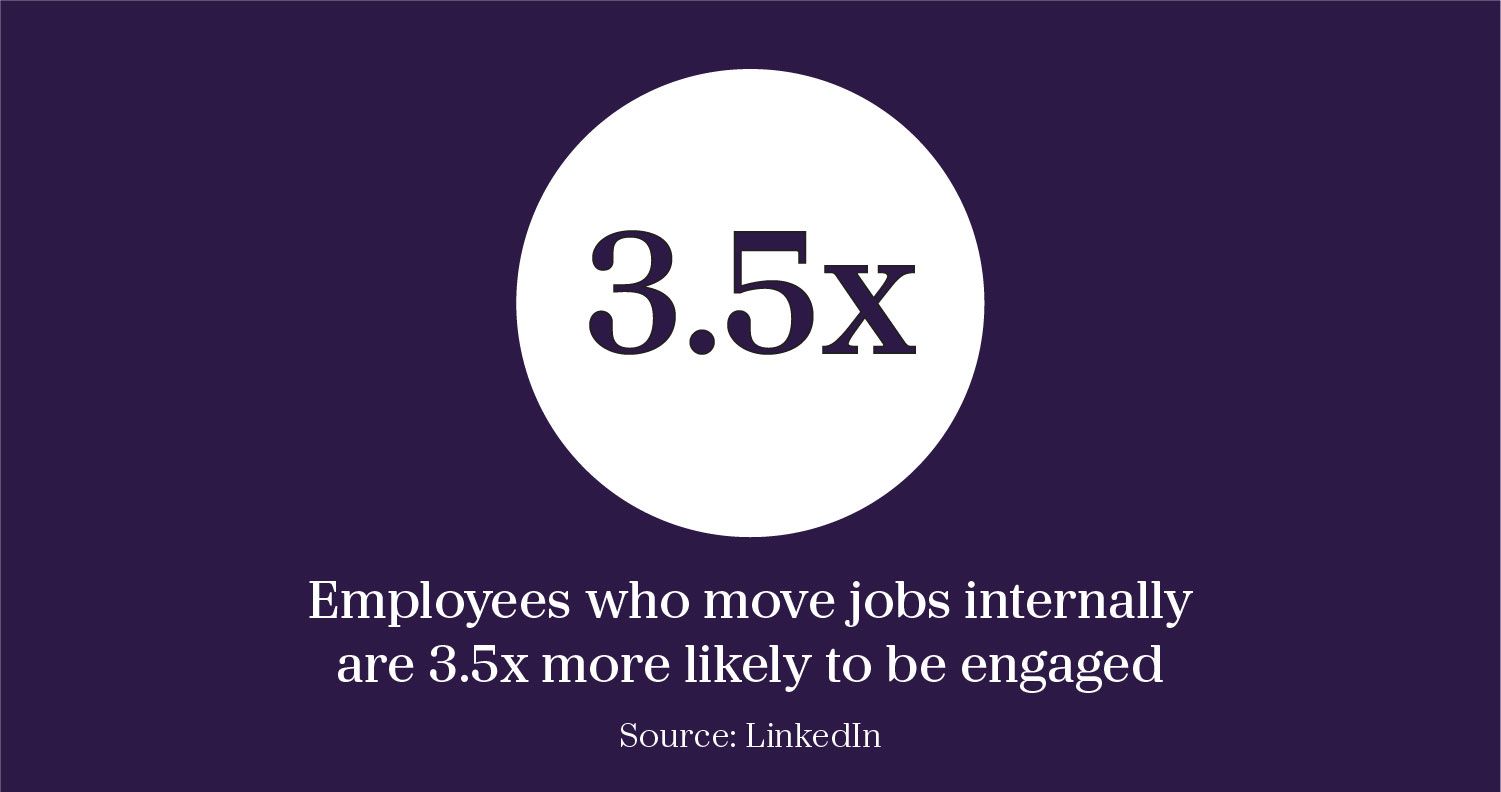
Combating this ‘who you know, not what you know’ culture requires being more explicit about the opportunities available internally and better understanding the capabilities of your existing talent.
This could mean creating a talent marketplace by posting all roles internally and looking at sponsorship of underrepresented high potential talent, placing them in specific talent programmes where they have access to senior leaders and their skills and accomplishments are exposed to new networks and opportunities.
It also means being aware of how your internal communications and employee engagement strategies impact different demographics. Two-way communication is key.
“I’ve seen issues with getting women and people of colour to apply for internal roles. In focus groups I conducted for clients, many saw internal postings as perfunctory, believing hiring managers had already chosen their desired candidate, so few believed in the process. At the same time, senior leaders were wondering why they had a lack of underrepresented applicants,” says Ellis.
“I found unsuccessful candidates often received no feedback about why they weren’t selected for a role. Therefore, when they saw the position filled by someone else, they determined the hiring manager had ‘pre-selected’ them. Failing to close the communication loop with unsuccessful candidates impacts them and everyone they talk to. Hiring managers should give specific feedback to candidates so they understand how to build their capabilities. While this may seem labour intense, it pays dividends to the individual and their network, instilling confidence in the overall process,” she adds.
Professor Jackie Ford is professor of leadership and organisation studies director at Durham University Business School. With colleagues, she has just completed a three year research project into diversity and inclusion challenges in the UK retail sector, focusing on 70,000+ employer Marks and Spencer.
She believes that one of the biggest mistakes organisations make when implementing diversity and inclusion initiatives is to treat all groups as one homogenised demographic with the same needs and desires.
“Leaders sometimes make assumptions about people who present with particular characteristics, whether those with disabilities, older women or different ethnicities. They make assumptions about how to support them or what they might want, rather than just asking them,” says Ford.
This can disengage employees and lead to inconsistency between what diversity initiatives are trying to achieve and what they actually do.
Ford gives two examples from the study. The first involves older female workers, who were seen as both valuable sources of knowledge and experience, but also as coming to the end of their careers and unlikely to want to get involved. The second is around talent hired from competitors to modernise the brand, but who were blocked by senior leaders who were unreceptive to their ideas – despite hiring them for this very reason. Poor communication and a lack of transparencies around your procedures can very quickly hinder culture change.
“Don’t just look at people as one culture or demographic and don’t assume one size fits all. If you make assumptions about how people will behave, the danger is that is what they will become and you won’t change,” says Ford.
Having a disconnect between employee value propositions and what you actually deliver can lose you diverse talent – so it is vital leaders set the right example.
“Organisations are working really hard to hire the talent they need, so it’s incumbent on all leaders to create an environment that supports diverse talent and matches what they were sold in the hiring process,” says Paul Modley, director diversity, equity and inclusion at AMS.
Doing so means hiring diverse talent with a view to progressing them through the organisation, not just getting them in the door. The opportunity to develop is the key to retaining all talent.
“When it comes to making your organisation more diverse, yes you’re hiring for a particular role, but you also need to be thinking about roles down the line,” says Modley.
For Modley, there are two reasons for this. Firstly, diverse talent needs to see progression pathways and role models in senior positions so that they know an organisation is serious about representation at the top level. Secondly, in a candidate driven market, progression means retention.
“All organisations are looking to hire diverse talent, so if they can see brilliant career mobility programmes, they’re more likely to stay with you. More importantly, if you’re selling the dream to candidates about the diversity of your organisation but they come in, look upwards and can’t see anybody like themselves, then the organisation has failed,” he says.
Some businesses are taking a very proactive approach to career mobility, with Modley detailing one organisation that set up an internal headhunting desk, where career mobility consultants were expected to understand the skills base of existing employees and actively encourage them to apply for internal roles.
While this might not be a cultural fit for most organisations, it does exemplify current market trends. In a talent scarce world, progressing the right candidates from within can improve employee engagement, motivation and reduce time to hire. Providing the right pathways for diverse talent gives businesses – and employees – the chance to finally make our management teams more representative. It’s the right thing to do.
Written by the Catalyst Editorial Board
with contributions from:
Jackie Ford
Professor, Durham University
Judy Ellis
SVP DEI Advisory, AMS
Paul Modley
DEI Managing Director, AMS
Professor Jackie Ford is professor of leadership and organisation studies director at Durham University Business School. With colleagues, she has just completed a three year research project into diversity and inclusion challenges in the UK retail sector, focusing on 70,000+ employer Marks and Spencer.
She believes that one of the biggest mistakes organisations make when implementing diversity and inclusion initiatives is to treat all groups as one homogenised demographic with the same needs and desires.
“Leaders sometimes make assumptions about people who present with particular characteristics, whether those with disabilities, older women or different ethnicities. They make assumptions about how to support them or what they might want, rather than just asking them,” says Ford.
This can disengage employees and lead to inconsistency between what diversity initiatives are trying to achieve and what they actually do.
Ford gives two examples from the study. The first involves older female workers, who were seen as both valuable sources of knowledge and experience, but also as coming to the end of their careers and unlikely to want to get involved. The second is around talent hired from competitors to modernise the brand, but who were blocked by senior leaders who were unreceptive to their ideas – despite hiring them for this very reason. Poor communication and a lack of transparencies around your procedures can very quickly hinder culture change.
“Don’t just look at people as one culture or demographic and don’t assume one size fits all. If you make assumptions about how people will behave, the danger is that is what they will become and you won’t change,” says Ford.
Having a disconnect between employee value propositions and what you actually deliver can lose you diverse talent – so it is vital leaders set the right example.
“Organisations are working really hard to hire the talent they need, so it’s incumbent on all leaders to create an environment that supports diverse talent and matches what they were sold in the hiring process,” says Paul Modley, director diversity, equity and inclusion at AMS.
Doing so means hiring diverse talent with a view to progressing them through the organisation, not just getting them in the door. The opportunity to develop is the key to retaining all talent.
“When it comes to making your organisation more diverse, yes you’re hiring for a particular role, but you also need to be thinking about roles down the line,” says Modley.
For Modley, there are two reasons for this. Firstly, diverse talent needs to see progression pathways and role models in senior positions so that they know an organisation is serious about representation at the top level. Secondly, in a candidate driven market, progression means retention.
“All organisations are looking to hire diverse talent, so if they can see brilliant career mobility programmes, they’re more likely to stay with you. More importantly, if you’re selling the dream to candidates about the diversity of your organisation but they come in, look upwards and can’t see anybody like themselves, then the organisation has failed,” he says.
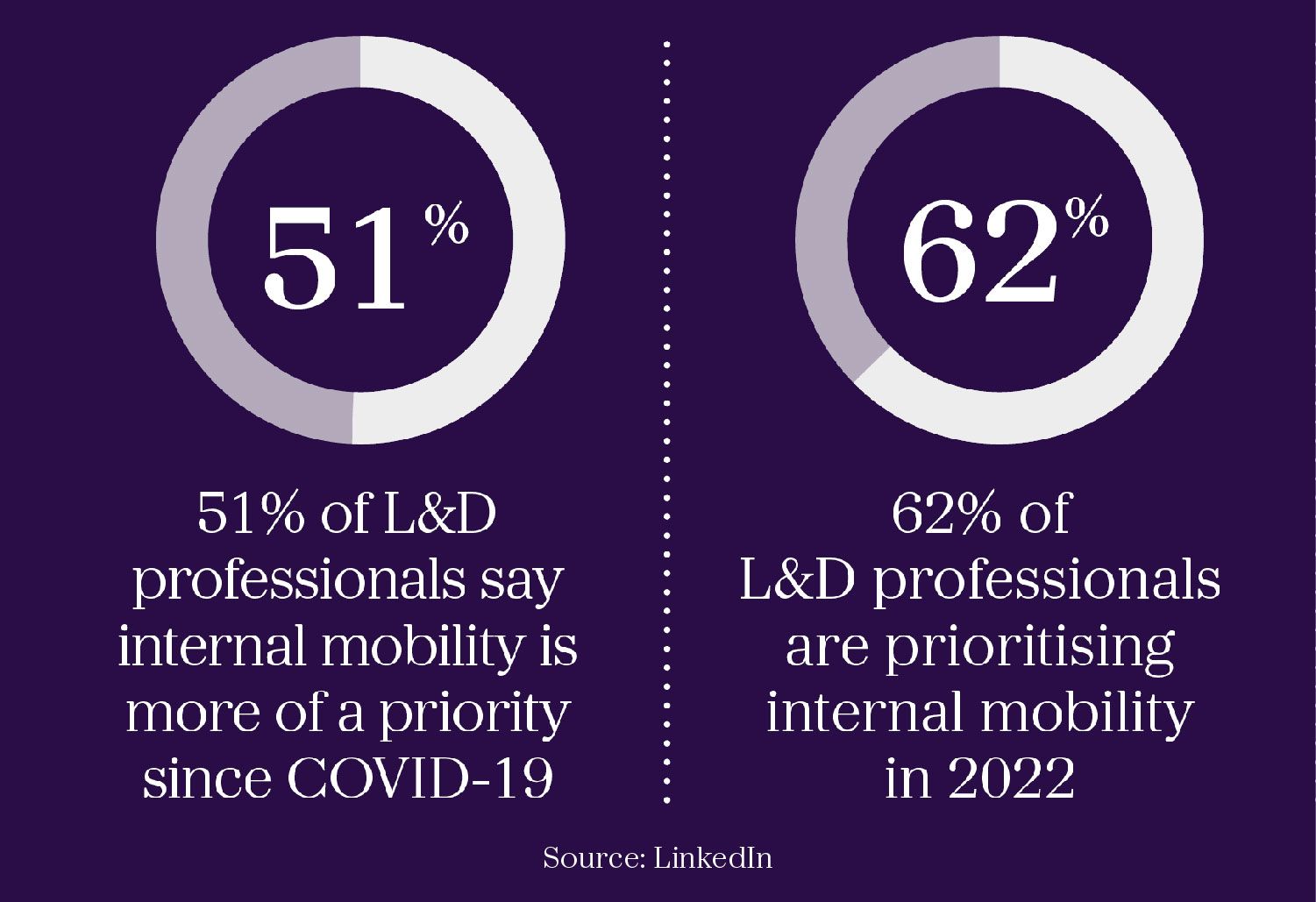
Some businesses are taking a very proactive approach to career mobility, with Modley detailing one organisation that set up an internal headhunting desk, where career mobility consultants were expected to understand the skills base of existing employees and actively encourage them to apply for internal roles.
While this might not be a cultural fit for most organisations, it does exemplify current market trends. In a talent scarce world, progressing the right candidates from within can improve employee engagement, motivation and reduce time to hire. Providing the right pathways for diverse talent gives businesses – and employees – the chance to finally make our management teams more representative. It’s the right thing to do.
Written by the Catalyst Editorial Board
with contributions from:
Jackie Ford
Professor, Durham University
Judy Ellis
SVP DEI Advisory, AMS
Paul Modley
DEI Managing Director, AMS
The Great Resignation has created an unprecedented wave of global employee turnover, with severe shortages in certain job roles leading to fierce competition for the best talent.
Contributors:
Dr. Kiki Leutner, Lecturer, Goldsmiths University of London
Michelle Hainsworth, Managing Director, AMS

The Great Resignation has created an unprecedented wave of global employee turnover, with severe shortages in certain job roles leading to fierce competition for the best talent.
In the US, nearly four million Americans quit their jobs each month in 2021 according to the Bureau of Labor Statistics, with job openings at a historic high. As of December last year, there were just under two open positions for every unemployed person in the United States.
One area that is particularly oversubscribed is tech talent, with digital transformation brought about by the pandemic further driving demand. Amazon announced plans to hire 55,000 new people in the US and Facebook needs another 10,000 European tech employees to build out its Metaverse proposition. And yet there isn’t enough talent to go around. Germany alone needs to hire 780,000 tech specialists by 2026 to meet current requirements, while nearly 3.5 million cyber security jobs were left unfilled in 2021.
However, there is another sector facing huge talent shortages and bottlenecks in hiring people – and that’s recruiters, the very industry at the centre of solving the talent crunch brought about by the Great Resignation.
August 2021, there were more recruiter jobs advertised on LinkedIn than software engineer roles (364,970 to 342,586), with a 6.8 increase in recruiter jobs posted between June 2020 and June 2021. The data also suggests that hiring managers are increasingly swimming in the same talent pool when it comes to recruiter talent, with 59% of hires coming from a previous recruiting role, compared with 33% pre-pandemic.
Why? This is partly due to the number of talent professionals who were laid off during the pandemic coming back into new roles, but it’s also likely that the current hiring frenzy is seeing organisations stick to experienced recruiters who require less training, driving even fiercer competition.
As LinkedIn’s senior director of talent acquisition Erin Scruggs puts it: “Most of our new hires are coming from competitive offer situations where they were interviewing elsewhere and working with other companies’ recruiters.”
It is clear there is a significant and ongoing skills gap across all sectors including the talent space. Organisations that recruit inhouse are desperate to fill their talent needs while at the same time recruiters’ salaries are continuing to rise though there has been some softening here in recent months.
To help organisations meet this demand, AMS has launched Recruiter Skilling as part of the AMS Talent Lab offering, a new solution that helps businesses to build their inhouse recruitment teams by both identifying and hiring potential applicants, then provides expert training to ensure they succeed.
AMS provides applicants with ten weeks training in how to be a recruiter including a two week client specific training program to learn about their specific employee value proposition, culture, and systems. Once completed, the trainee works in the client environment but remains an AMS employee, who provide ongoing training and mentoring. The ultimate aim is for the individual to roll into the client’s inhouse recruitment team, becoming a permanent employee.
For AMS, one of the main aims of the programme is to open up recruitment to a more diverse field of people such as veterans and their spouses, older workers, returnees, people from different socio-economic backgrounds and varying minority groups. With this in mind, to become a successful future recruiter greater emphasis should be given to soft skills such as adaptability, business acumen, agility, and empathy.
In today’s ever changing world of work, it is imperative for a recruiter to demonstrate these core skills. Firstly, it importantly ensures recruitment teams are more representative of the people they are aiming to attract and ultimately hire, and secondly, the skills needed to sell a job are changing. And changing fast. More and more employees say they will only consider companies that have a purpose that resonates with their own values and belief systems. Policies around mental health and wellbeing as well as DE&I and sustainability / ESG activities are mattering more and more. Recruiters need to be able to sell a job, and be empathetic too. As a result, there is a new wave of recruiters coming in with a different skillset who will be able to close candidates more effectively and at pace.
The Great Resignation has created an unprecedented wave of global employee turnover, with severe shortages in certain job roles leading to fierce competition for the best talent.
In the US, nearly four million Americans quit their jobs each month in 2021 according to the Bureau of Labor Statistics, with job openings at a historic high. As of December last year, there were just under two open positions for every unemployed person in the United States.
One area that is particularly oversubscribed is tech talent, with digital transformation brought about by the pandemic further driving demand. Amazon announced plans to hire 55,000 new people in the US and Facebook needs another 10,000 European tech employees to build out its Metaverse proposition. And yet there isn’t enough talent to go around. Germany alone needs to hire 780,000 tech specialists by 2026 to meet current requirements, while nearly 3.5 million cyber security jobs were left unfilled in 2021.
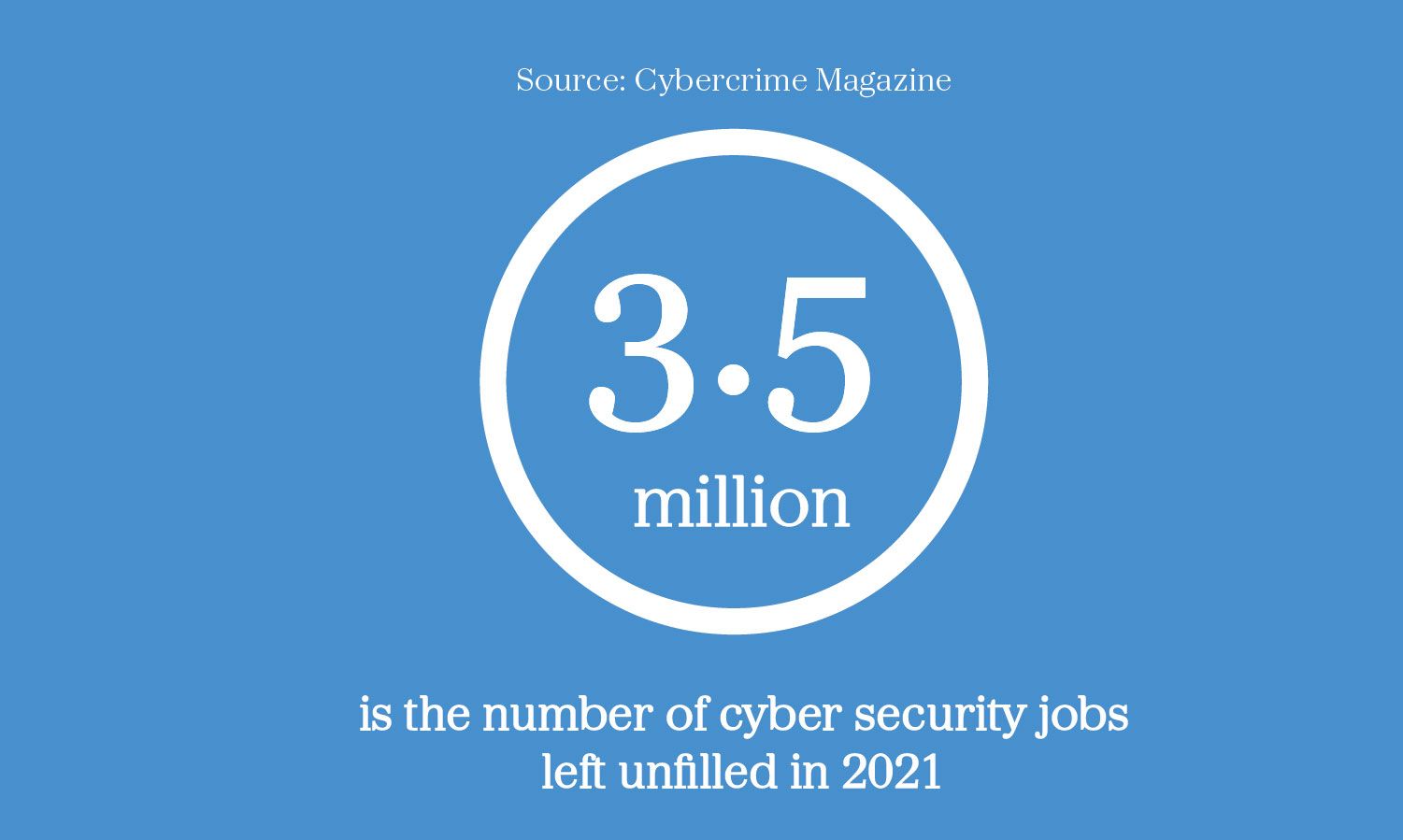
However, there is another sector facing huge talent shortages and bottlenecks in hiring people – and that’s recruiters, the very industry at the centre of solving the talent crunch brought about by the Great Resignation.
In August 2021, there were more recruiter jobs advertised on LinkedIn than software engineer roles (364,970 to 342,586), with a 6.8 increase in recruiter jobs posted between June 2020 and June 2021. The data also suggests that hiring managers are increasingly swimming in the same talent pool when it comes to recruiter talent, with 59% of hires coming from a previous recruiting role, compared with 33% pre-pandemic.
Why? This is partly due to the number of talent professionals who were laid off during the pandemic coming back into new roles, but it’s also likely that the current hiring frenzy is seeing organisations stick to experienced recruiters who require less training, driving even fiercer competition.
As LinkedIn’s senior director of talent acquisition Erin Scruggs puts it: “Most of our new hires are coming from competitive offer situations where they were interviewing elsewhere and working with other companies’ recruiters.”
It is clear there is a significant and ongoing skills gap across all sectors including the talent space. Organisations that recruit inhouse are desperate to fill their talent needs while at the same time recruiters’ salaries are continuing to rise though there has been some softening here in recent months.
To help organisations meet this demand, AMS has launched Recruiter Skilling as part of the AMS Talent Lab offering, a new solution that helps businesses to build their inhouse recruitment teams by both identifying and hiring potential applicants, then provides expert training to ensure they succeed.
AMS provides applicants with ten weeks training in how to be a recruiter including a two week client specific training program to learn about their specific employee value proposition, culture, and systems. Once completed, the trainee works in the client environment but remains an AMS employee, who provide ongoing training and mentoring. The ultimate aim is for the individual to roll into the client’s inhouse recruitment team, becoming a permanent employee.
For AMS, one of the main aims of the programme is to open up recruitment to a more diverse field of people such as veterans and their spouses, older workers, returnees, people from different socio-economic backgrounds and varying minority groups. With this in mind, to become a successful future recruiter greater emphasis should be given to soft skills such as adaptability, business acumen, agility, and empathy.
In today’s ever changing world of work, it is imperative for a recruiter to demonstrate these core skills. Firstly, it importantly ensures recruitment teams are more representative of the people they are aiming to attract and ultimately hire, and secondly, the skills needed to sell a job are changing. And changing fast. More and more employees say they will only consider companies that have a purpose that resonates with their own values and belief systems. Policies around mental health and wellbeing as well as DE&I and sustainability / ESG activities are mattering more and more. Recruiters need to be able to sell a job, and be empathetic too. As a result, there is a new wave of recruiters coming in with a different skillset who will be able to close candidates more effectively and at pace.
A recent Josh Bersin post entitled The Definitive Guide to Recruitment: Human-Centred Talent Acquisition looked at the skills a modern recruiter requires by surveying 600 companies. It suggests that recruiters need to move away from technical knowledge of job roles to softer, more rounded skills like collaboration, branding, and employee experience, ‘personalising candidate experiences’, ‘building authentic marketing to appeal to top talent’ and ‘flexing with changing business needs’. The modern recruitment professional is a strategic ally and influencer on business goals, it suggests.
Bersin’s research also advocates the use of technology to strengthen talent pipelines, though he admits most companies remain in the dark about how to effectively do so. Nevertheless, his research suggests that technology can drive key metrics.
“Companies that employ AI throughout their recruitment processes are four times more likely to boast a strong candidate pipeline. Likewise, those that leverage a variety of digital hiring solutions like online assessments, virtual interview platforms and pre-hire chatbots, are twice as likely to be able to attract and recruit the right talent,” he writes.
Dr Kiki Leutner is a lecturer in occupational psychology at Goldsmiths College, University of London and co-author of The future of recruitment: using the new science of talent analytics to get your recruitment right.
Like Bersin, she believes that technology can drive huge efficiencies in the recruitment process – and that the near universal use of video interviews during and post-COVID shows recruiters can adapt easily.
“There are two key benefits to recruitment technology in the post-COVID era. One is time to hire. You can communicate with candidates and hire much quicker using automated text messages, standardised online processes and game-based assessments.
The second is ease of application for candidates. When applicants have lots of opportunities to choose from, you lose them when you put them through hours of in-person testing or don’t respond promptly,” she says.
Another important outcome from technology is the opportunity to reduce bias in recruiting, whether through gamified testing which is less stressful and more inclusive than panel interviews, or through machine learning aimed at removing human bias in selection processes.
“We’re seeing more companies use analytics in their video interviews or applicant tracking systems. If you have a platform all applicants go through, you can compare data to ask, ‘are we more diverse in applicants this year?’ The main goal is to get recruiters thinking about hiring in a data driven way,” she says.
This is a challenge that some are meeting better than others. “We still have a mindset where hiring managers think they are the best judge of character. Whether unconsciously or consciously, they still want to recruit the same mould of people,” says Michelle Hainsworth, managing director, for Tech Skilling at AMS Talent Lab.
Like the Recruiter Skilling programme, Tech Skilling takes individuals with adjacent skills and retrains them into new tech roles, before placing them with clients. Again, the aim is to diversify the sector and solve skill shortages, which has seen demand sky rocket.
“Recently I’ve heard a lot about candidates ghosting. They have so much choice that they don’t even bother to tell you they’re not turning up on day one after they’ve accepted the job. They’re getting multiple offers and buy-back from existing employers,” says Hainsworth.
The solution isn’t simply offering higher salaries, although they are yet to slow down. Rather, says Hainsworth, it’s also about organisations offering purpose at work, development opportunities and work/life balance – and recruiters knowing how to sell this. Candidate engagement and experience has never been more important.
“Wellbeing, mental health, social and corporate responsibility – all these things are becoming more important to people. I don’t think that those organisations that simply have a pay strategy will win people back long-term.
“It’s not just about getting people through the door, it’s about what you do after that,” adds Hainsworth.
Recruiters might be the first line of attack in getting talent through the door, but increasingly, they also have a part to play in keeping your best talent with you. Developing the skills needed to do so means looking beyond traditional recruiter profiles and developing a more rounded talent acquisition team. It’s time to be brave.
written by the Catalyst Editorial Board
with contributions from:
Dr. Kiki Leutner
Lecturer, Goldsmiths University of London
Michelle Hainsworth
Managing Director, AMS
A recent Josh Bersin post entitled The Definitive Guide to Recruitment: Human-Centred Talent Acquisition looked at the skills a modern recruiter requires by surveying 600 companies. It suggests that recruiters need to move away from technical knowledge of job roles to softer, more rounded skills like collaboration, branding, and employee experience, ‘personalising candidate experiences’, ‘building authentic marketing to appeal to top talent’ and ‘flexing with changing business needs’. The modern recruitment professional is a strategic ally and influencer on business goals, it suggests.
Bersin’s research also advocates the use of technology to strengthen talent pipelines, though he admits most companies remain in the dark about how to effectively do so. Nevertheless, his research suggests that technology can drive key metrics.
“Companies that employ AI throughout their recruitment processes are four times more likely to boast a strong candidate pipeline. Likewise, those that leverage a variety of digital hiring solutions like online assessments, virtual interview platforms and pre-hire chatbots, are twice as likely to be able to attract and recruit the right talent,” he writes.
Dr Kiki Leutner is a lecturer in occupational psychology at Goldsmiths College, University of London and co-author of The future of recruitment: using the new science of talent analytics to get your recruitment right.
Like Bersin, she believes that technology can drive huge efficiencies in the recruitment process – and that the near universal use of video interviews during and post-COVID shows recruiters can adapt easily.
“There are two key benefits to recruitment technology in the post-COVID era. One is time to hire. You can communicate with candidates and hire much quicker using automated text messages, standardised online processes and game-based assessments.
The second is ease of application for candidates. When applicants have lots of opportunities to choose from, you lose them when you put them through hours of in-person testing or don’t respond promptly,” she says.
Another important outcome from technology is the opportunity to reduce bias in recruiting, whether through gamified testing which is less stressful and more inclusive than panel interviews, or through machine learning aimed at removing human bias in selection processes.
“We’re seeing more companies use analytics in their video interviews or applicant tracking systems. If you have a platform all applicants go through, you can compare data to ask, ‘are we more diverse in applicants this year?’ The main goal is to get recruiters thinking about hiring in a data driven way,” she says.
This is a challenge that some are meeting better than others. “We still have a mindset where hiring managers think they are the best judge of character. Whether unconsciously or consciously, they still want to recruit the same mould of people,” says Michelle Hainsworth, managing director, for Tech Skilling at AMS Talent Lab.
Like the Recruiter Skilling programme, Tech Skilling takes individuals with adjacent skills and retrains them into new tech roles, before placing them with clients. Again, the aim is to diversify the sector and solve skill shortages, which has seen demand skyrocket.
“Recently I’ve heard a lot about candidates ghosting. They have so much choice that they don’t even bother to tell you they’re not turning up on day one after they’ve accepted the job. They’re getting multiple offers and buy-back from existing employers,” says Hainsworth.
The solution isn’t simply offering higher salaries, although they are yet to slow down. Rather, says Hainsworth, it’s also about organisations offering purpose at work, development opportunities and work/life balance – and recruiters knowing how to sell this. Candidate engagement and experience has never been more important.
“Wellbeing, mental health, social and corporate responsibility – all these things are becoming more important to people. I don’t think that those organisations that simply have a pay strategy will win people back long-term.
“It’s not just about getting people through the door, it’s about what you do after that,” adds Hainsworth.
Recruiters might be the first line of attack in getting talent through the door, but increasingly, they also have a part to play in keeping your best talent with you. Developing the skills needed to do so means looking beyond traditional recruiter profiles and developing a more rounded talent acquisition team. It’s time to be brave.
written by the Catalyst Editorial Board
with contributions from:
Dr. Kiki Leutner
Lecturer, Goldsmiths University of London
Michelle Hainsworth
Managing Director, Tech Skilling, AMS
In a period of just a few months, COVID-19 brought about more change to how businesses operate than the previous decade. Lockdowns, remote working and an end to business travel forced organisations to accelerate adoption of digital practices.
Contributors:
Helen Ashton, Founder, Shape Beyond
Jonathan Kestenbaum, Managing Director, AMS

Lockdowns, remote working and an end to business travel forced organisations to accelerate adoption of digital practices, from online sales – ecommerce sales in the US grew by 43% in the first half of 2020 – to virtual meetings and remote onboarding.
According to a 2020 McKinsey & Company report, ‘COVID-19 pushed companies over the technology tipping point, transforming business forever’. The report surveyed almost 1,000 c-suite executives across industry, finding that companies had accelerated digitisation of customer and supply chain interaction and internal operations by three to four years, with the share of digitally enabled products in their portfolios accelerating by an unprecedented seven years.
Meeting the pace of this change has required huge investment in talent and technology, but perhaps the biggest challenge has been creating the right culture, systems and processes to ensure digital advances don’t leave existing employees behind. So how can organisations get the balance of technology and touch right?
“The simple answer is to think about your people first and include them on the whole journey. In my experience of transformations, leaders come up with detailed plans and in the bottom corner you find a couple of lines on people and culture. If you don’t spend the time getting teams to understand why the business needs to transform in the first place,or involve them in the planning and testing of what is changing, then it is quite likely things will fail when you launch,” says Helen Ashton, founder of transformation consultancy Shape Beyond.
Ashton’s 25 year business career has included roles as CFO of online fashion retailer ASOS, CEO of commercial equipment company JLA and several executive positions in banking with Barclaycard and Lloyds Banking Group. Change management has been a constant throughout her career, but achieving success is not easy, particularly in digital transformations.
“When you talk about digital transformation, there are two things. One is that it can sound way more techie than it is in reality. Day-to-day, it could be about automating a process that you normally do, making the job easier. If you can align it around doing the best for the customer and making life easier, existing employees can understand and accept it.
“The second is around hiring people with specialist skillsets to create new architecture or develop new ideas. This is more tricky, as these people have lots of opportunities and can be choosy about the sort of organisation they work for, the benefits they get and the organisational culture. This is why businesses need to think about their culture. It’s not just about retaining the people you have, it’s also attracting new talent,” adds Ashton.
However, how organisations hire this new talent has changed too. Overnight, businesses – or at least those still recruiting – had to switch to video interviewing and remote onboarding. Graduate recruitment events moved online, while some organisations focused on boosting administrative efficiency by automating parts of the hiring process, such as using chatbots to set up appointments or automating CV screening.
Now, the Great Resignation and rebounding economies has created a huge surge in recruitment, leaving talent professionals struggling to meet business demands on new hiring. The recruitment sector itself is under pressure, with the number of advertised recruiter roles soaring.
So, can talent technology help organisations get ahead?
“When you think about businesses keeping up with the pace of change, you have to stay on top of the talent acquisition technology market and how it’s changing,” says Jonathan Kestenbaum, managing director, technology strategy and partnerships at AMS.
“One of the big challenges I see is that vendors talk about features and functionality, and heads of talent talk about business problems. It’s easy to fall in love with a feature, but it might not have a business use in your organisation,” he adds.
Too often, recruitment technology fails because businesses buy products without fully understanding how they’ll incorporate them into their procedures, or how their people will use them. Without user buy-in and a strategy for deployment, technology can’t be implemented successfully.
Lockdowns, remote working and an end to business travel forced organisations to accelerate adoption of digital practices, from online sales – ecommerce sales in the US grew by 43% in the first half of 2020 – to virtual meetings and remote onboarding.
According to a 2020 McKinsey & Company report, ‘COVID-19 pushed companies over the technology tipping point, transforming business forever’. The report surveyed almost 1,000 c-suite executives across industry, finding that companies had accelerated digitisation of customer and supply chain interaction and internal operations by three to four years, with the share of digitally enabled products in their portfolios accelerating by an unprecedented seven years.
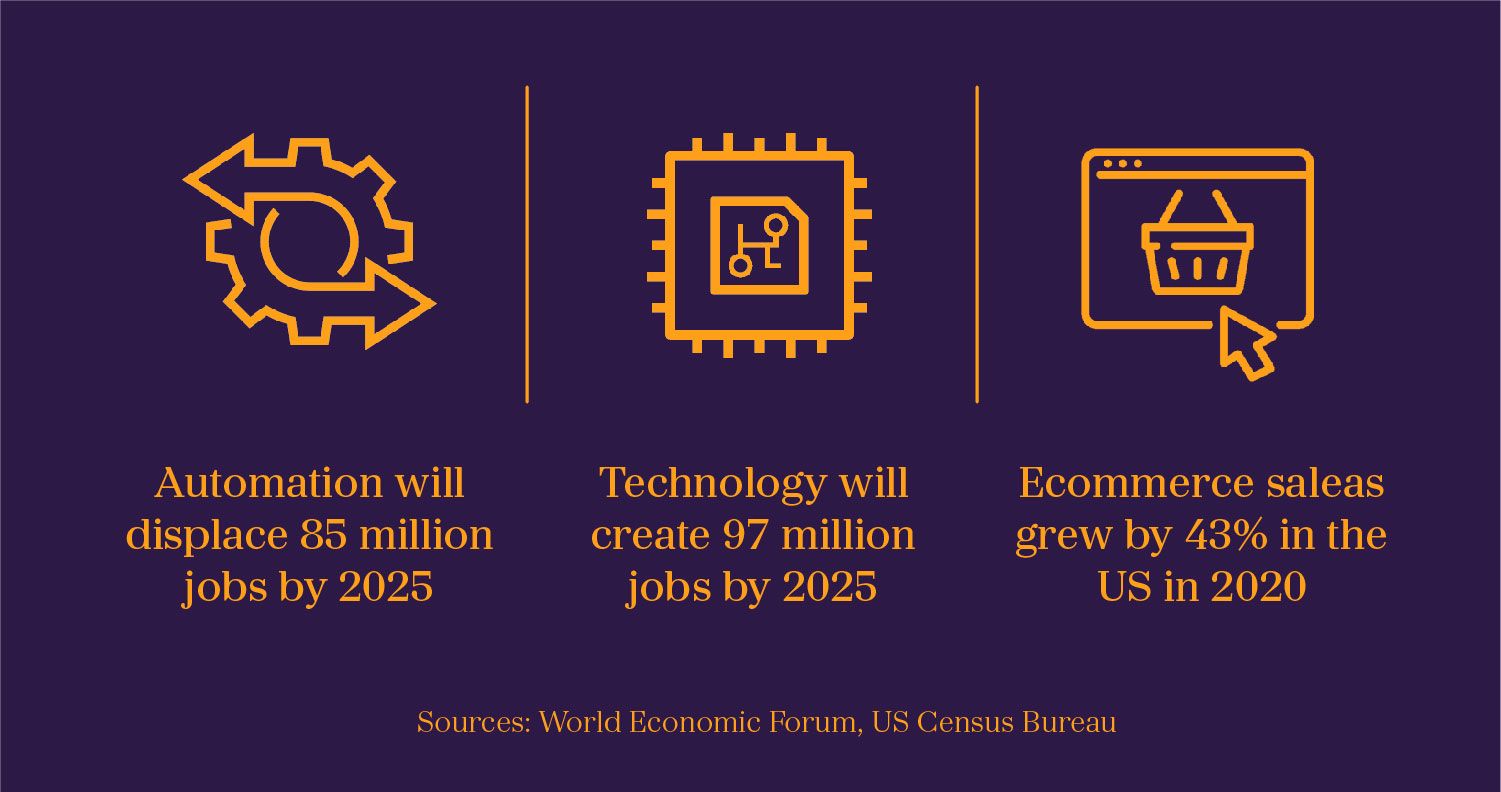
Meeting the pace of this change has required huge investment in talent and technology, but perhaps the biggest challenge has been creating the right culture, systems and processes to ensure digital advances don’t leave existing employees behind. So how can organisations get the balance of technology and touch right?
“The simple answer is to think about your people first and include them on the whole journey. In my experience of transformations, leaders come up with detailed plans and in the bottom corner you find a couple of lines on people and culture. If you don’t spend the time getting teams to understand why the business needs to transform in the first place,or involve them in the planning and testing of what is changing, then it is quite likely things will fail when you launch,” says Helen Ashton, founder of transformation consultancy Shape Beyond.
Ashton’s 25 year business career has included roles as CFO of online fashion retailer ASOS, CEO of commercial equipment company JLA and several executive positions in banking with Barclaycard and Lloyds Banking Group. Change management has been a constant throughout her career, but achieving success is not easy, particularly in digital transformations.
“When you talk about digital transformation, there are two things. One is that it can sound way more techie than it is in reality. Day-to-day, it could be about automating a process that you normally do, making the job easier. If you can align it around doing the best for the customer and making life easier, existing employees can understand and accept it.
“The second is around hiring people with specialist skillsets to create new architecture or develop new ideas. This is more tricky, as these people have lots of opportunities and can be choosy about the sort of organisation they work for, the benefits they get and the organisational culture. This is why businesses need to think about their culture. It’s not just about retaining the people you have, it’s also attracting new talent,” adds Ashton.
However, how organisations hire this new talent has changed too. Overnight, businesses – or at least those still recruiting – had to switch to video interviewing and remote onboarding. Graduate recruitment events moved online, while some organisations focused on boosting administrative efficiency by automating parts of the hiring process, such as using chatbots to set up appointments or automating CV screening.
Now, the Great Resignation and rebounding economies has created a huge surge in recruitment, leaving talent professionals struggling to meet business demands on new hiring. The recruitment sector itself is under pressure, with the number of advertised recruiter roles soaring.
So, can talent technology help organisations get ahead?
“When you think about businesses keeping up with the pace of change, you have to stay on top of the talent acquisition technology market and how it’s changing,” says Jonathan Kestenbaum, managing director, technology strategy and partnerships at AMS.
“One of the big challenges I see is that vendors talk about features and functionality, and heads of talent talk about business problems. It’s easy to fall in love with a feature, but it might not have a business use in your organisation,” he adds.
Too often, recruitment technology fails because businesses buy products without fully understanding how they’ll incorporate them into their procedures, or how their people will use them. Without user buy-in and a strategy for deployment, technology can’t be implemented successfully.
Kestenbaum’s team supports organisations through the entire technology adoption process, from identifying the right product through implementation and optimisation. The starting point for all businesses should be to understand their own strategic needs and transformation journey.
“What do you need to focus on next? What type of organisation are you and where are you on your digital transformation journey? Disney has very different talent acquisition challenges to Deloitte, so it’s about understanding your own brand and requirements and not looking to others,” says Kestenbaum.
“Secondly, it’s about tying technology to key performance indicators and measuring against that. Will the technology decrease my time to hire? Will it improve diversity and inclusion? Will it increase the quality of candidates? These are the questions you need to ask,” he adds.
Ultimately, the success or not of digital transformations and technology adoptions depends on the culture of the company using it and the employees leading it. Like Ashton, Kestenbaum believes that taking your people with you on that journey – and empowering them to lead it – is key. Technology is a people enabler, not the other way round.
“99% of the time when technology fails is when you don’t change your process and people around it. It’s all about taking your people with you,” he says.
So, are the robots taking over? Not quite. Back in 2020, the World Economic Forum predicted that automation would displace 85 million jobs by 2025 – but that technology would create an extra 97 million jobs over the same period. The pandemic might have accelerated the pace of digital change, but human skills and qualities remain very much the future of work.
“We fundamentally believe that the future will be a combination of tech and touch,” says Kestenbaum.
“Technology will not replace people – but it will make them more strategic. Technology will compute and people will engage, allowing us to have deeper, more meaningful conversations.”
written by the Catalyst Editorial Board
with contributions from:
Helen Ashton
Founder, Shape Beyond
Jonathan Kestenbaum
Managing Director, AMS
Kestenbaum’s team supports organisations through the entire technology adoption process, from identifying the right product through implementation and optimisation. The starting point for all businesses should be to understand their own strategic needs and transformation journey.
“What do you need to focus on next? What type of organisation are you and where are you on your digital transformation journey? Disney has very different talent acquisition challenges to Deloitte, so it’s about understanding your own brand and requirements and not looking to others,” says Kestenbaum.
“Secondly, it’s about tying technology to key performance indicators and measuring against that. Will the technology decrease my time to hire? Will it improve diversity and inclusion? Will it increase the quality of candidates? These are the questions you need to ask,” he adds.
Ultimately, the success or not of digital transformations and technology adoptions depends on the culture of the company using it and the employees leading it. Like Ashton, Kestenbaum believes that taking your people with you on that journey – and empowering them to lead it – is key. Technology is a people enabler, not the other way round.
“99% of the time when technology fails is when you don’t change your process and people around it. It’s all about taking your people with you,” he says.
So, are the robots taking over? Not quite. Back in 2020, the World Economic Forum predicted that automation would displace 85 million jobs by 2025 – but that technology would create an extra 97 million jobs over the same period. The pandemic might have accelerated the pace of digital change, but human skills and qualities remain very much the future of work.
“We fundamentally believe that the future will be a combination of tech and touch,” says Kestenbaum.
“Technology will not replace people – but it will make them more strategic. Technology will compute and people will engage, allowing us to have deeper, more meaningful conversations.”
written by the Catalyst Editorial Board
with contributions from:
Helen Ashton
Founder, Shape Beyond
Jonathan Kestenbaum
Managing Director, AMS
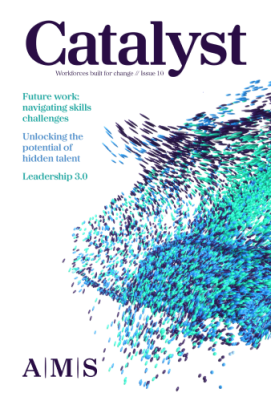
The future of work is really about the future of skills. As we progress through the COVID-19 pandemic, organisations and individuals are beginning to re-examine what the world of work looks like and what we need to succeed. For leaders, this might be about demonstrating the emotional intelligence required to thrive during the pandemic. For organisations, it’s about looking at how we recruit, develop and upskill talent to be the best they can be.
In this edition of Catalyst, we examine how companies and individuals will have to work in partnership to create and build workforces of the future. We look at how organisations can move beyond traditional talent pipelines to tap into the skills of people from excluded, neurodiverse and marginalised backgrounds.
Topics in this issue include:
Featuring insights from our clients and partners, this issue includes perspectives from Santander, Bristol Myers Squibb, Nationwide, bol.com, European Investment Bank, Staples and Beam, alongside columns from Dave Ulrich of the RBL Group, Frans Campher of Imperial College, Christian Stadler of Warwick Business School and Dr. Nicola Klein of Rotterdam School of Management.
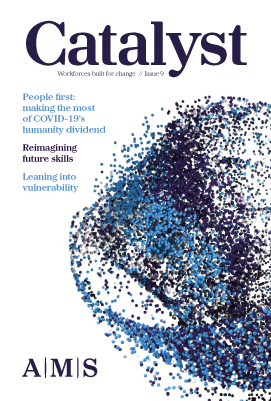
As we learn to live with COVID-19 and to reimagine ‘normality’, there is a need to explore new ways of bringing people together at work and to consider the human consequences of the pandemic.
In this edition of Catalyst, we draw on our collective experience (at AMS and beyond) over the past 18 months to discuss the ‘COVID humanity dividend’ – and how to reap it. We explore the themes of wellbeing, inclusion, purpose, collaboration, new ways of working, diversity, upskilling and engagement.
Featuring insights from our clients and partners, this issue includes perspectives from Nestle, Medtronic, Essilor Russia, Rinna, Bank of America, HSBC, Morgan Stanley, and NatWest, alongside thought-provoking opinion pieces from Amy Edmondson of Harvard Business School, Dr Hannes Leroy of Rotterdam School of Management and Dr Michelle Rogan and Dr Anne ter Val of Imperial Collage.
Topics in this issue include:
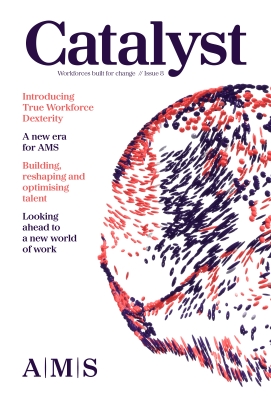
If 2020 taught us anything, it’s that it’s even more critical than ever to define what talent means in different, and changing, environments. The latest edition of Catalyst explores the rapidly shifting work landscape and what designing a workforce built for change really means.
Packed with in-depth features and insight, this issue features perspectives from our clients, Baker Hughes, Bristol Myers Squibb, Deloitte, Equinor, Gilead Sciences, Marsh McLennan and Synchrony, alongside inspiring op-eds from leading thinkers across the globe such as Josh Bersin, Margaret Heffernan and Jacob Morgan.
Topics in this issue include:
To mark AMS’s 2021 rebrand, Catalyst also has a new look and feel, mirroring our new and distinctive visual identity. These changes reflect our ambition to remain at the cutting edge of thinking around talent – meeting the evolving needs of our clients.
We hope you enjoy the issue!
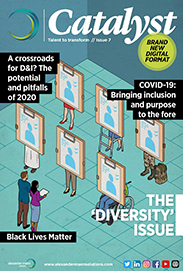
Continuing from our last two issues, we’ve invited world-leading businesses, clients, and esteemed academics to revisit key themes of dexterity, diversity, and digitisation discussed in issue 4, from the perspective of business in wake of the COVID-19 pandemic.
With unstoppable change impacting every business—in the last few months and for the foreseeable future—we deepen our exploration into the concept of diversity with a curated collection of relevant, engaging and thought-provoking content related to the world of talent.
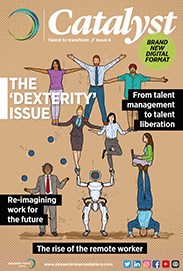
Continuing from our last issue, we’ve invited world-leading businesses, clients, and esteemed academics to revisit key themes of dexterity, diversity, and digitisation discussed in issue 4, from the perspective of business in wake of the COVID-19 pandemic.
With unstoppable change impacting every business—in the last few months and for the foreseeable future—we deepen our exploration into the concept of dexterity with a curated collection of relevant, engaging and thought-provoking content related to the world of talent.
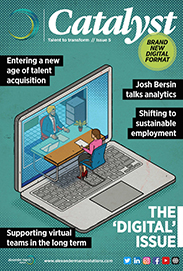
In our last issue, we explored the themes of dexterity, diversity, and digitisation. In this and the next two issues that follow, we continue on those themes—now with the perspective of a world rocked by COVID-19.
In keeping with our changing world, we’ve also changed the format of the Catalyst magazine.
The time for paper-based magazines may not be completely over, but with advances in technology, our changing work environment, and choices on how we spend our time, it seemed clear that it was time to shift Catalyst from a content-rich, physical magazine to a digestible, completely digital format, that retains the same level of quality content.
Our first issue in this new format, appropriately The ‘Digital’ Issue, is the first in a series of three—followed by issues around dexterity and diversity in the coming months.
In this issue we hear from HR influencer Josh Bersin and other business leaders from around the globe as they assess and analyse the current state of business and provide insight to how other organisations can adapt and move forward.


